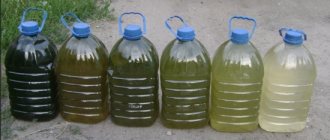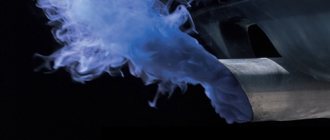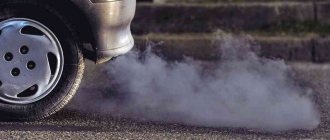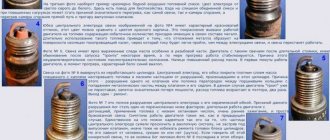Today we will talk about antifreeze, which is the coolant for your car engine. There are many types of liquid on the market, but today we will talk about the two most popular in Russia - red and green. We will tell you which antifreeze is better, as well as how they differ.
General composition of two antifreezes
Before comparing red and green liquids in order to find out your favorite, you should take a closer look at their composition. It is what underlies the antifreeze that will determine its effectiveness and the correct operation of the cooling system. Depending on the manufacturer, the composition, of course, is different, but all brands contain a concentrate of water with glycol - this is what determines:
- resistance to sub-zero temperatures,
- specific heat capacity,
- fluid viscosity, as well as the ability to remain on the walls of the expansion tank,
- the force of negative impacts on the rubber seals inside the cooling system.
In addition to the concentrate mentioned above, the composition of the coolant is supplemented with distilled water - this helps to raise the temperature threshold, making the antifreeze resistant to freezing even at minus 40 degrees. Various additives are added to the concentrate with the distillate:
- protect against corrosion – reduce the risk of rust on the metal elements of the system,
- anti-foam – prevents the formation of foam inside the system,
- stabilizing - help maintain the same decent level of coolant performance under different operating conditions.
Existing classification of coolants
All quality manufactured products must comply with the following standards (G11, G12, G13). In addition, according to the chemical composition, antifreeze is divided into the following types:
- Carboxylate , which are distinguished by better performance in terms of resource use and basic performance characteristics. They are completely free of any inorganic ingredients. Recommended for use in domestic cars. Since 2005, all domestic cars have had the opportunity to switch to this type of coolant. Such products comply with G12 and G12+ standards.
- Traditional type . Such substances are produced using inorganic technologies. Today, such products are practically not produced and they can only be found in underground workshops where low-quality counterfeits are produced.
- Hybrid . They are produced on the latest technological lines, which allows us to obtain products that fully comply with G11 standards. It is used primarily for initial refueling of BMW and Mercedes cars.
- Lobridaceae . It first appeared on the shelves of auto stores in 2008 and fully complies with the requirements of G12 and G13. It is distinguished by the presence in its composition of additives made on the basis of inorganic compounds such as silicates.
Conclusion
Thus, when choosing between red and green antifreeze, be guided by the recommendations of the car manufacturers and the desired results - if you want to cover the system with a thick protective film, take green, but be prepared that over time such a film reduces heat transfer and crumbles, contaminating the cooling system. If you only want to deal with existing pockets of corrosion, take red, but be prepared that the product will not do anything to prevent the re-formation of corrosion. In addition, be guided by the type of material from which your radiator is made - if one of the colors does not suit it, then you, in fact, will not have a choice.
Is it possible to mix?
During the operation of the vehicle, it becomes necessary to add fluid to the recommended level. In such a situation, some motorists are forced to mix green and red antifreeze.
This approach to solving the problem that has arisen is incorrect for the following reasons:
- When mixing two antifreezes, green and red, a violent chemical reaction will occur due to the fact that organic and inorganic additives will be combined.
- Will cause overheating of the power unit.
- Sediment will form on the cooling system parts.
- The protective film on the surface of the parts will be destroyed.
Good to know: Is it possible to mix antifreeze with antifreeze in a car cooling system?
All of these above reasons will ultimately cause engine failure.
Why are additives needed at all?
Now, probably, many people are thinking - why are these additives needed at all, because antifreeze consists of ethylene glycol + water, everything seems to be great! Doesn't boil or freeze! Why are additives still there?
I wondered this too, and here's what I get:
A mixture of ethylene glycol + water, for all its apparent perfection, is, to put it mildly, imperfect! The thing is, this liquid turns out to be extremely active! If you pour it into your car's cooling system , in a matter of months it will corrode all your rubber and metal pipes and pipes, destroy radiators and even the engine block! To curb their aggressiveness, scientists began to add various additives that prevent corrosion and other negative phenomena from appearing.
The additives are not the same; there is always a search for a more advanced one, which will be cheap and also effectively curb all the negative manifestations of antifreeze. To distinguish them, a universal solution was adopted - additives began to be painted in certain colors in order to distinguish the capabilities of liquids. Thus, the colors red, green or blue appeared.
Now in more detail.
Same component
You probably don’t need to be a “super chemist” to know that most of the antifreeze compositions are the same - ethylene glycol (propylene glycol, ethanediol, etc.) + distilled water, approximately 80% of the total volume. If we talk about ethylene glycol and others, then this is a simple dihydric alcohol that has a sweetish odor and a viscous consistency - it can withstand positive temperatures of 196 degrees, but negative temperatures of only “-11” degrees Celsius further freezes.
To increase the freezing threshold it is diluted with water, with the right approach you can achieve “-38” or even “-65” degrees, which is quite enough for all regions of our country.
There is a second component: additives, only 20% of them in the working composition, are what color our liquids red or green or blue.
Additives are required! Without them, the composition would not work correctly and would quickly destroy the walls of metal pipes and radiators. If you want, they protect against the aggressive effects of dihydric alcohols, and each additive works differently.
You are probably even more confused, but everything is simple, read the next paragraph.
How to dilute correctly
Now we will tell you a method that will allow you to mix antifreeze as safely as possible if its level has dropped to a minimum. So, our expansion tank is almost empty. Driving with this level of antifreeze is dangerous - the car will not have enough cooling and it will boil. What to do in this case? Since the additive packages in different brands of antifreeze differ, you can restore the coolant level using distilled water.
It is included in any antifreeze (no matter what group it is - G11, 12 or 12+). As practice shows, the properties of a liquid do not change when mixed with water. Manufacturers recommend diluting concentrate using the same principle.
What dangers might await you? The only pitfall is the freezing point of the liquid. Don't use a lot of water. In this case, when cold weather sets in, the coolant may freeze. Antifreeze density is lost. If we talk about specific numbers, for most regions of Russia the figure of 1.04 grams per cubic centimeter is considered critical. In this situation, the liquid freezes at -12 degrees Celsius. To prevent the coolant from freezing at -30, the concentration of distilled water should not exceed 65 percent of the total volume of liquid.
About the concentrate
Earlier we mentioned this type of liquid as concentrate. What it is? This product is a kind of semi-finished product. The composition contains everything you need (additives, ethylene glycol) except water. You need to add it yourself. Why isn't this done in production right away? The use of concentrates allows you to reduce the cost of transportation and storage of products. After all, the volume of such a canister is reduced almost threefold. And distilled water can be obtained anywhere. But you won’t be able to save money this way. The price of the concentrate with the condition of purchasing water is the same as in the case of ready-made antifreeze (maximum savings of 2-3 percent).
note
When choosing a new antifreeze, take into account the fact that not all companies adhere to the European standard when manufacturing liquids. For example, some Japanese brands produce group 12 antifreeze and color it green.
The service life is up to five years. Also, the color can be crimson, blue, and even yellow. All this is done so that in the event of a breakdown the driver can determine the location of the leak. Therefore, when purchasing, pay special attention not to the color, but to the group to which this or that model belongs. And always use distilled water for topping up.
You may also be interested
How are antifreezes different?
Since the coolant affects the system even when the vehicle is not in use, it should be understood that its choice is critically important. Experts will tell you how antifreeze differs from each other.
SINTEC oils - confidence in the future
Choosing oil for modern equipment is an extremely crucial moment. Units are becoming more and more sophisticated, requirements for lubricants are increasing almost every year, and old formulations can no longer provide reliable protection and trouble-free operation. Stores and service centers offer a huge number of motor and other oils for all types of cars. Most of them are released under [...]
Color function
Strictly speaking, in addition to the main types of antifreeze, there are also yellow and purple. And traditional red can look like crimson, blue can look like light blue, and green can look like light green. There may also be mixtures of different shades, for example, blue-green antifreeze or red-orange. Each manufacturer is free to produce products of any shade, since there are no strict regulations indicating that different compositions should be colored in a certain way. Therefore, adding a dye to a naturally colorless liquid is carried out for the following purposes:
- prevent accidental confusion of antifreeze with water, since the toxic components in it can lead to fatal poisoning;
- distinguish the properties of one line of coolants from others produced by the same manufacturer;
- ensure quick identification of leaks, since the bright and sometimes fluorescent liquid is easy to notice.
Multi-colored antifreezes are available on sale, but are in less demand, since an unspoken rule regarding coloring still exists, and often motorists do not want to take risks by purchasing liquid of an unconventional color.
However, all antifreezes perform the same functions, namely, they protect the engine from overheating, and the motor, pipes and hoses from corrosion and damage. This allows you to safely use the car both in the summer heat and in winter frosts.
Main component
All types of antifreeze contain dihydric alcohols. More often it is ethylene glycol, but recently manufacturers have begun to switch to propylene glycol as a less active, toxic and more modern and environmentally friendly substance. Both alcohols have high boiling points of almost 200 °C, but they freeze already at -11 °C.
Distilled water in the composition helps to overcome this disadvantage, the combination with which gives the usual indicator of -38 °C, and in some ratios -65 °C. This is enough for normal operation of the car in any region of Russia.
You cannot pour ordinary water to cool the system. It boils already at 100 °C, and freezes at 0 °C, leading to breakdowns and ruptures of rubber elements.
Video “Instructions for replacing refrigerant”
You will learn how to replace antifreeze, flush the cooling system and radiator unit from the video filmed by the CAR CITY channel.
Do you have any questions? Specialists and readers of the AUTODVIG website will help you ask a question
Was this article helpful?
Thank you for your opinion!
The article was useful. Please share the information with your friends.
Yes (100.00%)
No
X
Please write what is wrong and leave recommendations on the article
Cancel reply
Rate this article: ( 4 votes, average: 5.00 out of 5)
Discuss the article:
Mixing different types
There is a misconception that you can only combine liquids of the same color, but this is not entirely true. First of all, you need to look at the composition of the product. It can be completely identical even for two different brands, but the shades will differ. And at the same time, two antifreezes of the same color can use the same dye, but completely different components.
Thus, you can even mix red and green antifreeze if the difference between them is only in color. But when combining liquids with different compositions, the mixture deteriorates. As it thickens and precipitates, it harms the engine elements and can hopelessly damage it.
The best manufacturers
Several companies have established themselves as the best suppliers of antifreeze. Among them there are both Russian and foreign manufacturers. According to consumer reviews, the products of the following companies are in demand:
- Tosol-sintez is one of the few Russian manufacturers of auto chemicals that enjoys the trust of motorists.
- Obninskorgsintez is still a fairly young Russian company producing high-quality oils and antifreezes.
- Liqui Moly is a German company that distributes its products in 120 countries.
- Motul is a French company with a 165-year history that produces biodegradable materials.
You can choose products from these manufacturers or other reputable companies.
The main thing is that the car works properly and does not cause inconvenience. Sometimes the choice of liquid is so difficult that several brands are mixed. But there are rules for this.
Why are they painted?
Why are antifreeze different colors? After all, the various colors of antifreeze are only misleading. It should be said that antifreeze itself is colorless and transparent. And there are three reasons for coloring it:
- Difference from water. Coolant is poisonous, so the main reason is so that it can be distinguished from water and not be drunk by mistake.
- Difference from each other. As a rule, the same brand has a whole line of liquids with different properties. If they were all the same color it would create confusion.
- Finding leaks. What color is antifreeze usually? Whatever it is, it is bright. This is done in order to quickly find leaks. For the same purpose, manufacturers often add a fluorescent dye to the composition, which can be detected under ultraviolet light.
Well, don’t forget about the marketing component. For example, there is a popular opinion that red is the best - so the manufacturer will use this shade.











